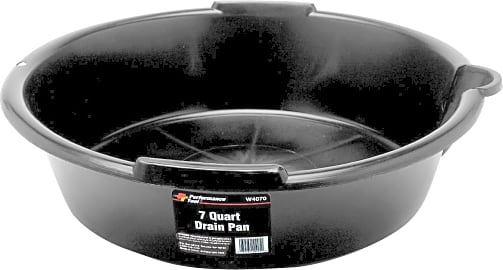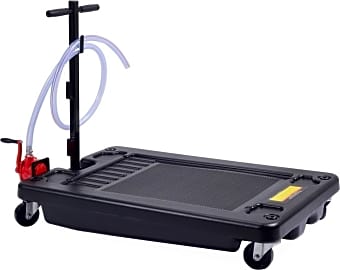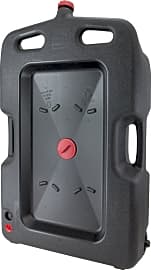The 10 Best Oil Drain Pans

This wiki has been updated 43 times since it was first published in June of 2016. If you tend to do a lot of your own maintenance on passenger vehicles, lawn mowers, or farming equipment, you'll need one of these handy drain pans when it's time to change the oil. We've included some exceptionally cheap and basic designs for the cost-conscious, as well as a few more feature-rich and durable models that will work great in a professional garage setting. When users buy our independently chosen editorial recommendations, we may earn commissions to help fund the Wiki.
Editor's Notes
March 21, 2019:
It's a seemingly simple product, but get the wrong one, and you'll have a mess on your hands that even sawdust, borax, and hours of scrubbing may never fully clean up. Most people who are simply changing oil on one or two vehicles every now and then will be satisfied by the top Lisle model. It's a well-engineered piece of equipment, and relatively easy for most people to pour out. If it's going to see heavier use, as well as spend a lot of time sliding across the shop floor around heavy equipment, consider the Lumax LX-1629, whose construction is so rugged, some users can literally stand on its walls, and it won't break -- and it was not a small man who shared a picture of himself doing just that. The Midwest Can Company makes another very strong model, which is not only built of rugged materials, but also is a closed-top design, which offers it additional structural integrity. The ATD isn't quite as rugged, but its two-tiered design does a great job at preventing splashback. The GarageBoss, Lumax LX-1632, and Hopkins FloTool are each variations on the sealed-reservoir style, which can be helpful if you aren't headed out to recycle your oil right away, although they aren't long-term storage or long-distance transport solutions. If you like to get all your oil changes done in one fell swoop, the Crude Control can help, because it is, quite frankly, massive. And if all these fancy doohickeys seem unneeded or over-engineered, the Performance Tool W4070 is about as simple as they come, and about as cheap as they get, but good luck trying to keep the garage floor clean while you're sliding it around and emptying it.
Choosing the Right Oil Drain Pan
Luckily, these pans aren't terribly expensive, so even if you end up with one that doesn't work for you, it won't put you in the poorhouse.
We know what you're thinking already: it's an oil drain pan. How much thought really needs to go into buying this thing?
We'll be honest with you. If you get the wrong one, it's not going to be the end of the world. That said, there are a few things you should keep in mind while looking around, so that you can be sure the one you get is one that actually makes your life easier.
The most important thing is that it's big enough to hold all the oil you need it to hold. They're not all uniform in this regard, as you can get a model that holds just a couple of liters or one that houses more than fifteen gallons. If you're changing the oil on heavy machinery, then you'll definitely need one of the larger options — and they're also great if you're lazy, as you don't have to empty them as often.
Speaking of emptying them, some have clearly-defined spouts that make pouring them out a cinch. This isn't strictly necessary, but when you're wrestling with a large, slippery pan, it's nice to have a little help getting the used oil out.
Also — and this may sound obvious, but you don't want to find out the hard way that you didn't think about this — make sure it will actually fit under your vehicle. Some are extremely tall and bulky, so if you have a compact car (and you don't have ramps), you'll want one that you can slide underneath it easily.
If you like to wait a long time before you empty it, it's useful to have one that allows you to see inside to check the fluid levels. The last thing you want is to have your car's oil pan draining while the drain pan overflows. Having two drain holes is helpful as well, as that prevents air from impeding the oil's exit.
Luckily, these pans aren't terribly expensive, so even if you end up with one that doesn't work for you, it won't put you in the poorhouse. Even better, they'll enable you to have lots of oil on hand, so you can feel like a real petroleum baron for once in your life.
How to Change Your Oil
If you're not the most mechanically-inclined, the thought of changing your own oil can be anxiety-inducing. However, it's actually one of the easier maintenance tasks to tackle, so it's a great way to save a little cash.
Start off by parking your car on a flat surface and engaging the parking brake. Wait a little while to begin if the car's been running, unless you've always wanted to feel what it'd be like to be one of those medieval soldiers who gets boiling oil poured on them.
Check your owner's manual to find out exactly how much to put in.
Slide the drain pan underneath the oil pan on the car, and jack it up if you're going to do that. Be sure to put chocks behind the wheels too, just in case.
There should be a plug at the end of the car's oil pan. Unscrew it, and be ready for lots of oil to come pouring out. This process could take a few minutes, so feel free to do anything except smoke a cigarette during this time.
After it's completely drained, replace the plug and find the filter. It should (hopefully) look just like the replacement you bought, and it will be somewhere near the engine. Unscrew it — again, it will be full of oil — and drop it in the drain pan. Then screw the new filter on.
Once the plug and filter have been replaced, it's time to pour the new oil in. Look for the oil cap on top of the engine (it will have a picture of an oil can on it). Unscrew the cap and pour the new oil in. Check your owner's manual to find out exactly how much to put in.
Before you're done, examine the dipstick to be sure that everything looks good. If it does, you're free to spend the rest of the afternoon bragging to everyone you know about how you're now something of a shade-tree mechanic.
Disposing of Used Oil Properly
There's only one problem with changing your own oil, and that's the fact that the used fluid is now your problem.
This lessens the need for importing or extracting new crude oil, which is fantastic for Mother Earth.
Whatever you do, don't just dump it out on the ground. Not only is that highly illegal, but it's absolutely horrible for the environment. Even a little spill can get into groundwater, rendering it undrinkable, or it can cause the soil to become unproductive. As a matter of fact, the EPA estimates that the liquid from just one oil change can contaminate up to a million gallons of water.
Instead, you should find a used oil recycling center near you. Some garages and mechanic's shops will also accept used motor oil, but they often charge a fee for doing so. You can drop off your old filters with them as well.
It's important to know that, if the collection shop is closed, you can't just drop it off anyway, unless they have clear directions for after-hours disposal. Leaving used motor oil at a closed shop is technically considered illegal dumping, which can cost you as much as ten grand a day in fines.
Once your oil has been safely dropped off, it can be safely recycled. Recycled motor oil is often used as fuel for heaters and furnaces, or it can also be filtered back into regular lubricating oil. This lessens the need for importing or extracting new crude oil, which is fantastic for Mother Earth.
Whatever you do, don't try to refine the oil yourself with a colander and a couple of towels in the kitchen sink. We learned that one the hard way.















